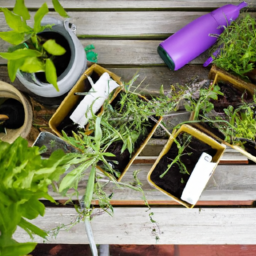How To Start Container Gardening
How To Start Container Gardening
How to Start Container Gardening
Container gardening is a great way to bring nature into your home, spruce up patios and decks, and create beautiful seasonal displays. With the right supplies and know-how, you can easily create stunning, compact gardens without complicated and expensive tools. Here's how to get started!
Choose The Right Containers
When it comes to container gardening, it's all about the container. Choose from a variety of materials, such as ceramic, terra-cotta, metal, and plastic, to find the right one for your project. Consider size, color, drainage, and of course, budget when making a selection.
Terra cotta
Popular for its classic, rustic character, terra-cotta is an inexpensive and durable choice. It does, however, require more care when it comes to drainage. To avoid waterlogging, remember to add drainage holes in the bottom of the pot.
Plastic
These containers are typically more lightweight and come in a variety of basic and decorative shapes that can suit almost any style. Plastic is also not as likely to crack in cold temperatures.
Metal
Metal pots and planters are sleek and modern, and come with good insulation properties that can help keep soil cooler on hot days. They can be a little heavier than plastic or terra-cotta, so consider where you plan on using them.
Ceramic
Ceramic pots come in a variety of styles and can add a decorative element to any garden. They are heavier than other materials, so make sure to check the weight capacity of the pot before purchasing.
Soil: What You Need to Know
Choosing the right soil is just as important as picking the perfect pot. Soil for containers needs to retain moisture, provide good drainage, and be lightweight. Avoid using topsoil from your yard; it has a tendency to compact and will make the pot difficult to water.
Look for a soil mix specifically for container gardening. You can also mix your own soil, using a combination of compost, peat moss, and perlite. For a container garden on the balcony, a soil-less mix such as coco coir or peat moss provides a great growing medium for vegetable and flower pots.
Give Your Plants the Correct Diet
Plants in containers will need more water and fertilizer than a garden plot. Make sure to check the soil moisture regularly (every other day, or even daily in hot weather) and avoid over-watering so the roots don't rot. Plants in containers also need balanced nutrition, usually from a granular or liquid fertilizer.
Also, think about positioning the pots in the right light. Each variety of plants has specific light requirements, and you can move the pots around for best results. A little research before you start will give you a good idea of what combination of sun, shade, and filtered light your plants or vegetables need.
Pest Control
Just like with a regular garden, container gardens can be vulnerable to pests and disease. Preventative measures like spraying plants with neem oil or a microbial pesticide and washing containers with a mild dish soap and warm water can help keep bugs at bay.
Brief Recap
Creating a container garden is a great way to bring nature into homes, balconies, and even small urban gardens. To get started, think about the type of container you want to use, the right soil and fertilizer for the plants, and positioning the pot in the right light for the specific variety you're growing. With the right supplies and a little know-how, you'll soon have a spectacular container garden that's sure to impress!

Previous Page
Next Page
